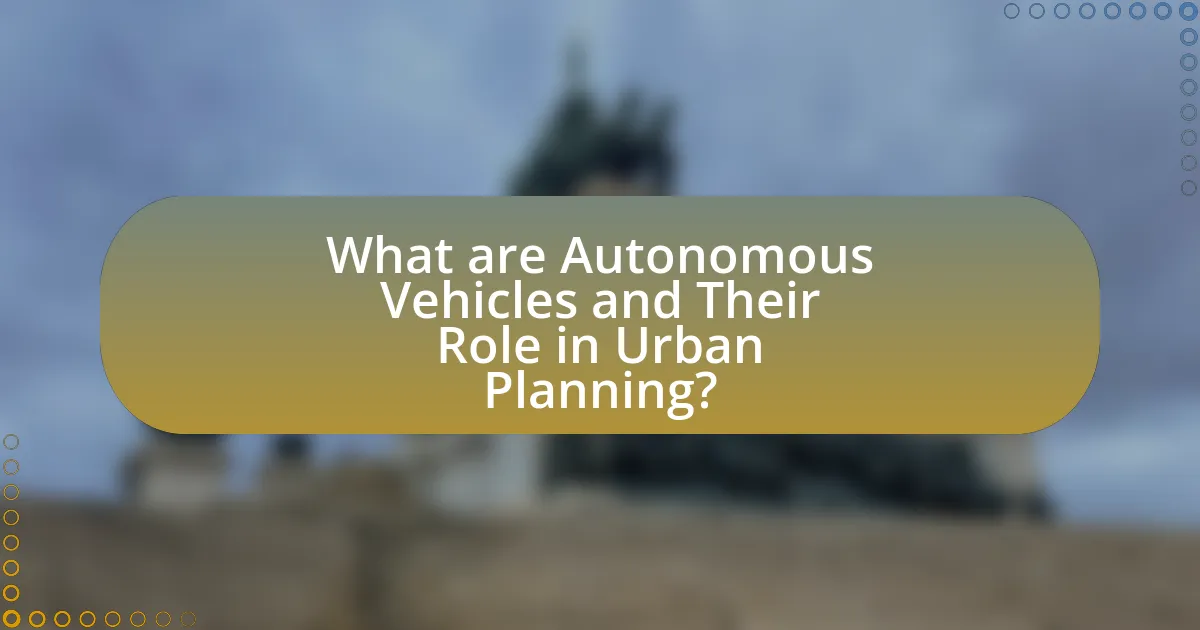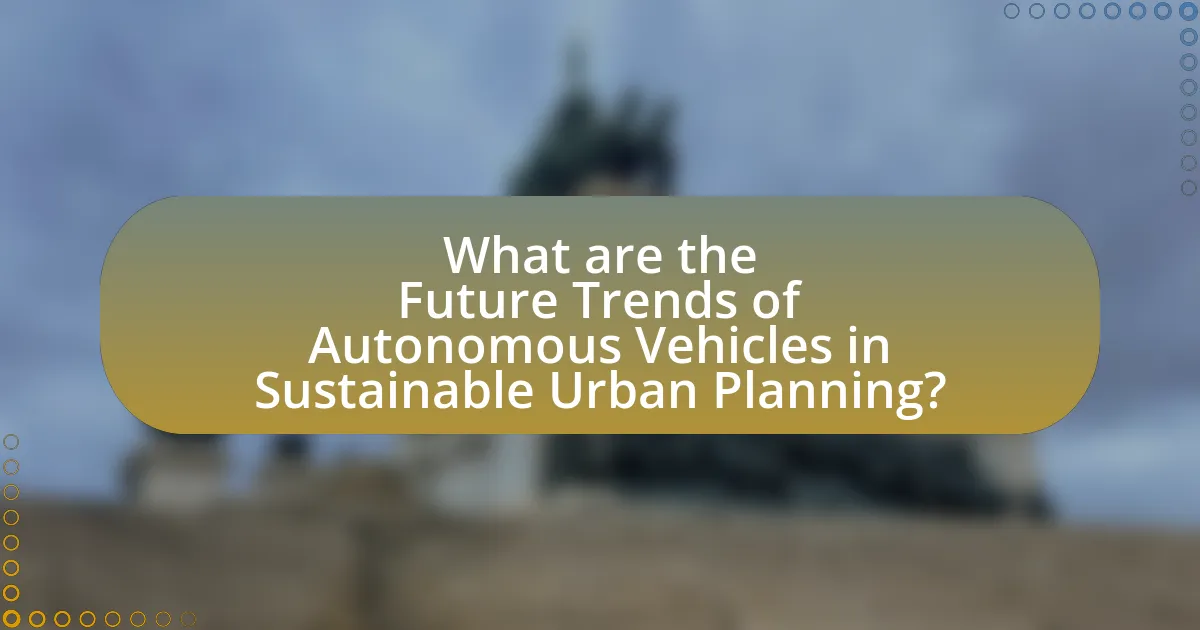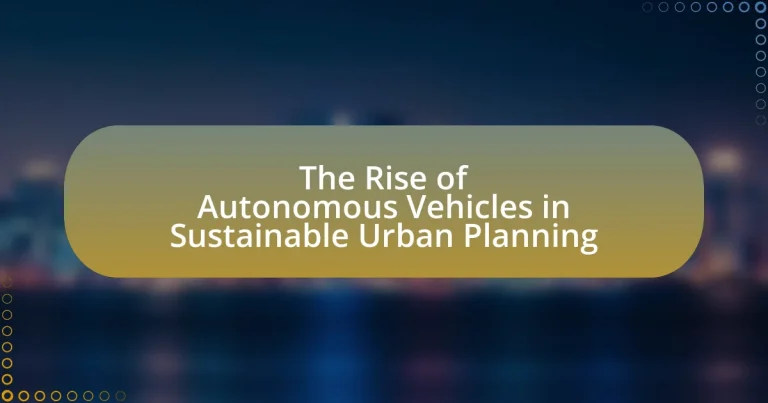Autonomous vehicles, or self-driving cars, are revolutionizing urban planning by enhancing traffic efficiency, reducing congestion, and lowering emissions. Equipped with advanced technologies such as sensors and artificial intelligence, these vehicles can navigate complex urban environments, optimize routes, and interact with existing infrastructure. The integration of autonomous vehicles is crucial for achieving sustainability goals, as studies indicate they can significantly decrease greenhouse gas emissions and improve urban mobility. However, challenges such as regulatory hurdles, safety concerns, and public perception issues must be addressed to facilitate their successful implementation in urban settings. This article explores the role of autonomous vehicles in sustainable urban planning, their operational technologies, environmental benefits, and the necessary infrastructure changes for their integration.

What are Autonomous Vehicles and Their Role in Urban Planning?
Autonomous vehicles are self-driving cars equipped with technology that allows them to navigate and operate without human intervention. Their role in urban planning is significant as they can enhance traffic efficiency, reduce congestion, and lower emissions by optimizing routes and decreasing the need for parking spaces. Studies indicate that the integration of autonomous vehicles into urban environments can lead to a 20-30% reduction in traffic congestion and a 10-15% decrease in greenhouse gas emissions, supporting sustainable urban development goals.
How do Autonomous Vehicles function within urban environments?
Autonomous vehicles function within urban environments by utilizing a combination of sensors, artificial intelligence, and advanced algorithms to navigate complex traffic scenarios. These vehicles employ technologies such as LIDAR, cameras, and radar to perceive their surroundings, allowing them to detect obstacles, pedestrians, and other vehicles in real-time. For instance, a study by the National Highway Traffic Safety Administration indicates that autonomous vehicles can reduce traffic accidents by up to 90% through their ability to react faster than human drivers. Additionally, these vehicles optimize routes and manage traffic flow, contributing to reduced congestion and lower emissions, which aligns with sustainable urban planning goals.
What technologies enable the operation of Autonomous Vehicles?
The technologies that enable the operation of Autonomous Vehicles include sensors, machine learning algorithms, and advanced computing systems. Sensors such as LIDAR, cameras, and radar provide real-time data about the vehicle’s surroundings, allowing it to detect obstacles, lane markings, and traffic signals. Machine learning algorithms process this data to make decisions and improve the vehicle’s performance over time. Advanced computing systems, including powerful onboard processors, facilitate the rapid analysis of data and execution of driving tasks. These technologies collectively ensure safe navigation and operation of autonomous vehicles in various environments.
How do Autonomous Vehicles interact with existing urban infrastructure?
Autonomous vehicles interact with existing urban infrastructure by utilizing advanced sensors and communication technologies to navigate and respond to their environment. These vehicles rely on infrastructure elements such as traffic signals, road signs, and lane markings to interpret traffic conditions and make driving decisions. For instance, studies indicate that autonomous vehicles can communicate with smart traffic signals to optimize traffic flow, reducing congestion by adjusting signal timings based on real-time vehicle data. Furthermore, the integration of autonomous vehicles with urban infrastructure can enhance safety by enabling features like automatic emergency braking in response to pedestrians or obstacles detected through infrastructure-based sensors. This interaction not only improves traffic efficiency but also supports sustainable urban planning by reducing emissions and promoting the use of shared autonomous mobility solutions.
Why is the integration of Autonomous Vehicles important for sustainability?
The integration of Autonomous Vehicles is important for sustainability because it can significantly reduce greenhouse gas emissions and improve urban mobility. Autonomous Vehicles are designed to optimize driving patterns, which can lead to decreased fuel consumption and lower emissions; studies indicate that widespread adoption could reduce emissions by up to 80% in urban areas. Furthermore, these vehicles can enhance public transportation efficiency, reduce traffic congestion, and promote shared mobility solutions, all of which contribute to a more sustainable urban environment.
What environmental benefits do Autonomous Vehicles provide?
Autonomous vehicles provide significant environmental benefits, primarily through reduced greenhouse gas emissions and improved energy efficiency. Studies indicate that these vehicles can optimize driving patterns, leading to smoother acceleration and braking, which in turn reduces fuel consumption. For instance, a report by the International Council on Clean Transportation found that autonomous vehicles could reduce emissions by up to 60% compared to traditional vehicles by utilizing electric powertrains and enhancing traffic flow. Additionally, the potential for shared autonomous vehicle services can decrease the total number of vehicles on the road, further lowering emissions and urban congestion.
How can Autonomous Vehicles reduce urban congestion?
Autonomous vehicles can reduce urban congestion by optimizing traffic flow through advanced algorithms and real-time data analysis. These vehicles communicate with each other and infrastructure, allowing for coordinated movement that minimizes stop-and-go traffic, which is a major contributor to congestion. Studies indicate that implementing autonomous vehicle technology could lead to a reduction in traffic delays by up to 30%, as they can maintain optimal speeds and reduce the need for excessive braking and acceleration. Additionally, autonomous vehicles can facilitate more efficient use of road space by enabling closer following distances and reducing the overall number of vehicles needed for transportation, further alleviating congestion in urban areas.

What are the Challenges of Implementing Autonomous Vehicles in Urban Areas?
The challenges of implementing autonomous vehicles in urban areas include complex traffic environments, regulatory hurdles, and public acceptance issues. Urban areas feature dense populations and intricate road networks, which complicate the navigation and decision-making processes of autonomous systems. Additionally, existing regulations often do not accommodate the unique operational needs of autonomous vehicles, leading to legal uncertainties. Public acceptance is also a significant barrier, as many individuals express concerns about safety, privacy, and the potential loss of jobs in driving-related sectors. These challenges must be addressed to facilitate the successful integration of autonomous vehicles into urban settings.
What regulatory hurdles must be overcome for Autonomous Vehicles?
Autonomous vehicles must overcome several regulatory hurdles, including the establishment of safety standards, liability frameworks, and data privacy regulations. Safety standards are crucial as they ensure that autonomous vehicles meet specific performance criteria to protect passengers and pedestrians; for instance, the National Highway Traffic Safety Administration (NHTSA) has been developing guidelines for testing and deploying these vehicles. Liability frameworks need to clarify who is responsible in the event of an accident involving an autonomous vehicle, which is essential for insurance and legal accountability. Additionally, data privacy regulations must address how the vast amounts of data collected by these vehicles are managed, ensuring compliance with laws like the General Data Protection Regulation (GDPR) in Europe. These regulatory challenges must be addressed to facilitate the safe integration of autonomous vehicles into urban environments.
How do safety concerns impact the deployment of Autonomous Vehicles?
Safety concerns significantly hinder the deployment of Autonomous Vehicles (AVs) by creating regulatory barriers and public skepticism. Regulatory bodies often impose stringent safety standards that AVs must meet before they can be widely adopted, which delays their introduction into the market. For instance, the National Highway Traffic Safety Administration (NHTSA) has established guidelines that require extensive testing and validation of AV technology to ensure it can operate safely in diverse environments. Additionally, public apprehension regarding the safety of AVs, fueled by high-profile accidents involving these vehicles, leads to resistance against their integration into urban settings. According to a 2021 survey by the American Automobile Association, 71% of respondents expressed fear of riding in a fully autonomous vehicle, highlighting the impact of safety perceptions on consumer acceptance. Thus, safety concerns directly influence both regulatory frameworks and public acceptance, ultimately affecting the pace of AV deployment in sustainable urban planning.
What public perception issues affect the acceptance of Autonomous Vehicles?
Public perception issues that affect the acceptance of Autonomous Vehicles include safety concerns, trust in technology, and ethical considerations. Safety concerns arise from high-profile accidents involving autonomous vehicles, leading to skepticism about their reliability. Trust in technology is influenced by the public’s understanding of how autonomous systems operate, with many individuals feeling uncertain about the decision-making processes of these vehicles. Ethical considerations, such as how autonomous vehicles should respond in accident scenarios, further complicate public acceptance. According to a 2020 survey by the American Automobile Association, 71% of respondents expressed fear of riding in a fully autonomous vehicle, highlighting the significant impact of these perception issues on acceptance.
How can cities prepare for the rise of Autonomous Vehicles?
Cities can prepare for the rise of Autonomous Vehicles (AVs) by investing in infrastructure that supports their integration, such as dedicated lanes and smart traffic management systems. Research indicates that cities implementing AV-friendly infrastructure can enhance traffic flow and reduce congestion; for example, a study by the Institute of Transportation Engineers found that dedicated AV lanes can improve travel times by up to 30%. Additionally, cities should update zoning laws to accommodate new mobility services and promote mixed-use developments that facilitate access to AVs. By proactively adapting urban planning strategies, cities can ensure a smoother transition to an AV-dominated transportation landscape.
What infrastructure changes are necessary to accommodate Autonomous Vehicles?
To accommodate Autonomous Vehicles (AVs), significant infrastructure changes are necessary, including the development of dedicated lanes, enhanced communication systems, and updated traffic management technologies. Dedicated lanes for AVs can improve traffic flow and safety by separating them from traditional vehicles, as seen in pilot programs in cities like San Francisco. Enhanced communication systems, such as Vehicle-to-Infrastructure (V2I) technology, enable AVs to interact with traffic signals and road conditions, improving navigation and reducing accidents. Additionally, updating traffic management technologies, including adaptive traffic signals and real-time data analytics, can optimize traffic patterns and enhance the overall efficiency of urban transportation systems. These changes are essential to ensure that AVs can operate safely and effectively within existing urban environments.
How can urban planners integrate Autonomous Vehicles into existing transportation systems?
Urban planners can integrate Autonomous Vehicles (AVs) into existing transportation systems by developing dedicated lanes and infrastructure that accommodate both AVs and traditional vehicles. This integration requires a comprehensive approach that includes updating traffic management systems to support AV technology, ensuring compatibility with public transit, and implementing policies that encourage the use of AVs for shared mobility solutions. For instance, cities like San Francisco have begun pilot programs that test AVs in real-world conditions, providing data on traffic flow and safety, which can inform future planning decisions. Additionally, studies indicate that integrating AVs can reduce congestion by optimizing traffic patterns, as demonstrated by research from the University of Michigan, which found that AVs could improve road efficiency by up to 30%.

What are the Future Trends of Autonomous Vehicles in Sustainable Urban Planning?
Future trends of autonomous vehicles in sustainable urban planning include increased integration with public transportation systems, enhanced traffic management through real-time data analytics, and the promotion of shared mobility solutions. These trends aim to reduce congestion and emissions while improving accessibility. For instance, cities like San Francisco and Amsterdam are piloting autonomous shuttle services that complement existing transit networks, demonstrating a shift towards multimodal transportation. Additionally, studies indicate that autonomous vehicles can optimize traffic flow, potentially reducing urban traffic by up to 30% when combined with smart infrastructure. This integration supports sustainable urban development by minimizing the need for extensive parking spaces and encouraging green spaces.
How will Autonomous Vehicles shape the future of urban mobility?
Autonomous vehicles will significantly transform urban mobility by enhancing efficiency, reducing congestion, and improving safety. These vehicles can optimize traffic flow through real-time data analysis and communication with infrastructure, leading to a projected 20-30% reduction in traffic congestion, as indicated by studies from the Institute of Transportation Engineers. Furthermore, autonomous vehicles are expected to decrease accident rates by up to 90% due to advanced safety features and reduced human error, according to research from the National Highway Traffic Safety Administration. This shift will facilitate more sustainable urban planning by enabling the repurposing of road space for pedestrians and cyclists, ultimately fostering a more integrated and efficient urban transport ecosystem.
What innovations are on the horizon for Autonomous Vehicle technology?
Innovations on the horizon for Autonomous Vehicle technology include advancements in artificial intelligence, improved sensor technologies, and enhanced vehicle-to-everything (V2X) communication systems. These developments aim to increase safety, efficiency, and integration into urban environments. For instance, AI algorithms are becoming more sophisticated, allowing vehicles to better interpret complex driving scenarios and make real-time decisions. Additionally, the integration of LiDAR and radar technologies is expected to enhance environmental perception, enabling vehicles to navigate safely in diverse conditions. Furthermore, V2X communication will facilitate seamless interaction between vehicles and infrastructure, optimizing traffic flow and reducing congestion. These innovations are supported by ongoing research and investment from major automotive companies and tech firms, indicating a strong trajectory towards fully autonomous systems in urban planning.
How might Autonomous Vehicles influence urban design and land use?
Autonomous vehicles (AVs) are likely to significantly influence urban design and land use by reducing the need for extensive parking spaces and enabling more efficient land utilization. As AVs can drop passengers off and park themselves in less central locations, cities may repurpose existing parking areas into green spaces, residential units, or commercial developments. Research from the University of California, Berkeley, indicates that AVs could reduce parking demand by up to 90%, allowing urban planners to redesign areas for mixed-use developments that promote walkability and community engagement. This shift in land use can lead to more sustainable urban environments, as cities adapt to prioritize public spaces and reduce reliance on personal vehicle ownership.
What best practices should cities adopt for successful integration of Autonomous Vehicles?
Cities should adopt a multi-faceted approach for the successful integration of Autonomous Vehicles (AVs), focusing on infrastructure development, regulatory frameworks, and public engagement. Infrastructure must include dedicated lanes and smart traffic management systems to accommodate AVs, as studies show that cities with such infrastructure experience smoother traffic flow and reduced congestion. Regulatory frameworks should prioritize safety and liability, ensuring clear guidelines for AV operation, which is supported by data indicating that well-defined regulations can enhance public trust and adoption rates. Public engagement is essential; cities should involve community stakeholders in planning processes to address concerns and gather feedback, as research indicates that inclusive practices lead to higher acceptance of new technologies.
How can collaboration between stakeholders enhance the implementation of Autonomous Vehicles?
Collaboration between stakeholders enhances the implementation of Autonomous Vehicles by fostering shared knowledge, aligning regulatory frameworks, and pooling resources for research and development. When automotive manufacturers, technology companies, government agencies, and urban planners work together, they can create a cohesive strategy that addresses safety, infrastructure needs, and public acceptance. For instance, the partnership between Waymo and various municipalities has led to pilot programs that test autonomous technology in real-world environments, demonstrating its viability and addressing community concerns. This collaborative approach not only accelerates technological advancements but also ensures that the deployment of autonomous vehicles aligns with urban sustainability goals, as seen in cities like San Francisco and Phoenix, where stakeholder collaboration has been crucial in integrating these vehicles into existing transportation systems.
What lessons can be learned from early adopters of Autonomous Vehicle technology?
Early adopters of Autonomous Vehicle technology demonstrate the importance of regulatory frameworks and public acceptance in successful implementation. For instance, cities like San Francisco and Phoenix have shown that establishing clear regulations and engaging with communities can facilitate smoother integration of autonomous vehicles into urban environments. Data from the National Highway Traffic Safety Administration indicates that public trust is crucial, as surveys reveal that 60% of individuals are more likely to support autonomous vehicles when they understand the safety measures in place. Additionally, early adopters highlight the need for robust infrastructure, as cities that invested in smart traffic systems experienced a 20% reduction in congestion, showcasing the benefits of aligning urban planning with autonomous technology.


